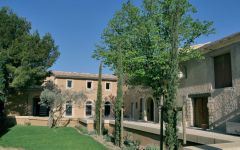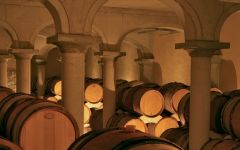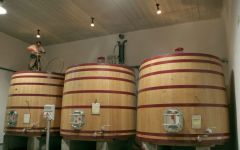Domaine de Beaurenard Chateauneuf-du-Pape Boisrenard Rouge 2017
-
Robert
Parker - Decanter
-
James
Suckling



Product Details
Your Rating
Somm Note
Winemaker Notes
Professional Ratings
-
Robert Parker's Wine Advocate
Mostly (66%) Grenache, with smaller amounts of Mourvèdre and Syrah (12% each), and tiny amounts of the other permitted varieties, the 2017 Chateauneuf du Pape Cuvee Boisrenard is inky in color, with aromas that hint at toasted coconut, black cherries and chocolate. It's a rich, decadent, full-bodied sexpot of a CdP that possess admirable concentration, a wonderfully creamy-silky texture and a long, long finish.
-
Decanter
Just 5% of this wine is matured in new oak barriques, the rest spending time in old barriques and foudres for 18 months. It's all destemmed fruit, lending a nose of raspberry with lifted notes of bergamot and cinnamon. It's full-bodied, rich and flowing on the palate, with a considerable weight of wet-clay tannins. An opulent style, it hangs on to its brightness and drinkability.
-
James Suckling
Lively and expressive red cherries and berries on the nose here. This has a very plush and vibrant, darker fruit feel to the palate with some sturdy fruit tannin and a nicely played oak frame to the finish.
Other Vintages
2020-
Jeb
Dunnuck - Decanter
-
James
Suckling -
Wine
Spectator
-
Jeb
Dunnuck -
James
Suckling -
Wine
Spectator -
Robert
Parker
-
Jeb
Dunnuck -
Robert
Parker -
Wine
Spectator - Decanter
-
James
Suckling
-
Wine
Spectator -
Jeb
Dunnuck -
James
Suckling -
Robert
Parker
-
Wine
Spectator -
Robert
Parker -
Wine
Enthusiast
-
Robert
Parker -
Wine
Spectator
-
Wine
Spectator -
Robert
Parker
-
Wine
Spectator -
Robert
Parker
-
Wine
Spectator -
Robert
Parker
-
Wine
Spectator -
Robert
Parker
-
Wine
Spectator -
Robert
Parker
-
Robert
Parker
-
Wine
Spectator -
Robert
Parker -
Wine
Enthusiast
-
Robert
Parker -
Wine
Spectator
-
Robert
Parker
-
Wine
Spectator -
Robert
Parker
-
Robert
Parker
-
Robert
Parker







The Coulons have estate-bottled their wines since the early 1900’s. Paul Coulon's father and grandfather were instrumental in creating the regulations of the Appellation Contrôlée system (Chateauneuf du Pape was France's first appellation contrôlée, in 1929). Detail oriented, meticulous to the point of perfectionism, visitors can peruse not only the informative Musée du Vin below their Rasteau vineyard, but detailed volumes for each vintage with ground temperatures, rainfall, hours of sunlight, etc.
Domaine de Beaurenard portfolio includes: Cotes du Rhone Rouge & Rose, Cotes du Rhone Villages Rasteau, Chateauneuf du Pape Rouge & Blanc and Chateauneuf du Pape Cuvee Boisrenard which is consistently one of Robert Parker and Stephen Tanzer's most highly rated Rhone wines.

With bold fruit flavors and accents of sweet spice, Grenache, Syrah and Mourvèdre form the base of the classic Rhône Red Blend, while Carignan, Cinsault and Counoise often come in to play. Though they originated from France’s southern Rhône Valley, with some creative interpretation, Rhône blends have also become popular in other countries. Somm Secret—Putting their own local spin on the Rhône Red Blend, those from Priorat often include Merlot and Cabernet Sauvignon. In California, it is not uncommon to see Petite Sirah make an appearance.

Famous for its full-bodied, seductive and spicy reds with flavor and aroma characteristics reminiscent of black cherry, baked raspberry, garrigue, olive tapenade, lavender and baking spice, Châteauneuf-du-Pape is the leading sub-appellation of the southern Rhône River Valley. Large pebbles resembling river rocks, called "galets" in French, dominate most of the terrain. The stones hold heat and reflect it back up to the low-lying gobelet-trained vines. Though the galets are typical, they are not prominent in every vineyard. Chateau Rayas is the most obvious deviation with very sandy soil.
According to law, eighteen grape varieties are allowed in Châteauneuf-du-Pape and most wines are blends of some mix of these. For reds, Grenache is the star player with Mourvedre and Syrah coming typically second. Others used include Cinsault, Counoise and occasionally Muscardin, Vaccarèse, Picquepoul Noir and Terret Noir.
Only about 6-7% of wine from Châteauneuf-du-Pape is white wine. Blends and single-varietal bottlings are typically based on the soft and floral Grenache Blanc but Clairette, Bourboulenc and Roussanne are grown with some significance.
The wine of Chateauneuf-du-Pape takes its name from the relocation of the papal court to Avignon. The lore says that after moving in 1309, Pope Clément V (after whom Chateau Pape-Clément in Pessac-Léognan is named) ordered that vines were planted. But it was actually his successor, John XXII, who established the vineyards. The name however, Chateauneuf-du-Pape, translated as "the pope's new castle," didn’t really stick until the 19th century.
